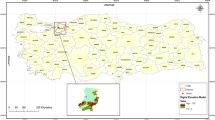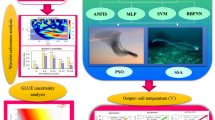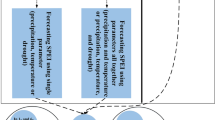Abstract
The modelling of drought is of utmost importance for the efficient management of water resources. This article used the adaptive neuro-fuzzy interface system (ANFIS), multilayer perceptron (MLP), radial basis function neural network (RBFNN), and support vector machine (SVM) models to forecast meteorological droughts in Iran. The spatial–temporal pattern of droughts in Iran was also found using recorded observation data from 1980 to 2014. A nomadic people algorithm (NPA) was utilized to train the ANFIS, MLP, RBFNN, and SVM models. Additionally, the NPA was benchmarked against the bat algorithm, salp swarm algorithm, and krill algorithm (KA). The hybrid ANFIS, MLP, RBFNN, and SVM models were used to forecast the 3-month standardized precipitation index. New evolutionary algorithms were utilized to improve the convergence speed of the soft computing models and their accuracy. First, random stations, namely, in Azarbayjan (northwest Iran), Khouzestan (southwest Iran), Khorasan (northeast Iran), and Sistan and Balouchestan (southeast Iran) were selected for the testing of the models. According to the results obtained from the Azarbayjan station, the Nash–Sutcliffe efficiency (NSE) was 0.93, 0.86, 0.85, and 0.83 for the ANFIS–NPA, MLP–NPA, RBFNN–NPA, and SVM–NPA models, respectively. For Sistan and Baloucehstan, the results indicated the superiority of the ANFIS–NPA model, followed by the MLP–NPA model, compared to the RBFNN–NPA and SVM–NPA models, and suggested that the hybrid models performed better than the standalone MLP, RBFNN, ANFIS, and SVM models. The second aim of the study was to capture the relationship between large-scale climate signals and drought indices by using a wavelet coherence analysis. The general results indicated that the NPA and wavelet coherence analysis are useful tools for modelling drought indices.


















Similar content being viewed by others
References
Abd-Elazim SM, Ali ES (2016) Load frequency controller design via BAT algorithm for nonlinear interconnected power system. Int J Electr Power Energy Syst 77:166–177
Abualigah LMQ (2019) Feature selection and enhanced krill herd algorithm for text document clustering. Springer, Berlin
Aamir M, Tu S, Tolouei-Rad M, Giasin K, Vafadar A (2020) Optimization and modeling of process parameters in multi-hole simultaneous drilling using Taguchi method and fuzzy logic approach. Materials 13(3):680
Ali Ghorbani M, Kazempour R, Chau KW, Shamshirband S, Taherei Ghazvinei P (2018) Forecasting pan evaporation with an integrated artificial neural network quantum-behaved particle swarm optimization model: a case study in Talesh, Northern Iran. Eng Appl Comput Fluid Mech 12(1):724–737
Araghi A, Martinez CJ, Adamowski J, Olesen JE (2019) Associations between large-scale climate oscillations and land surface phenology in Iran. Agric For Meteorol 278:107682
Asteris Panagiotis G et al (2019) "Krill herd algorithm-based neural network in structural seismic reliability evaluation. Mech Adv Mater Struct 26(13):1146–1153
Barua S, Perera BJC, Ng AWM, Tran D (2010) Drought forecasting using an aggregated drought index and artificial neural network. J Water Clim Change 1(3):193–206
Bayissa YA, Tadesse T, Svoboda M, Wardlow B, Poulsen C, Swigart J, Van Andel SJ (2019) Developing a satellite-based combined drought indicator to monitor agricultural drought: a case study for Ethiopia. GISci Remote Sens 56(5):718–748
Borji M, Malekian A, Salajegheh A, Ghadimi M (2016) Multi-time-scale analysis of hydrological drought forecasting using support vector regression (SVR) and artificial neural networks (ANN). Arab J Geosci 9(19):725
Bozorg-Haddad O, Karimirad I, Seifollahi-Aghmiuni S, Loáiciga HA (2015) Development and application of the bat algorithm for optimizing the operation of reservoir systems. J Water Resour Plan Manag 141(8):04014097
Belayneh A, Adamowski J, Khalil B, Quilty J (2016) Coupling machine learning methods with wavelet transforms and the bootstrap and boosting ensemble approaches for drought prediction. Atmos Res 172:37–47
Bui DT, Tuan TA, Hoang ND, Thanh NQ, Nguyen DB, Van Liem N, Pradhan B (2017) Spatial prediction of rainfall-induced landslides for the Lao Cai area (Vietnam) using a hybrid intelligent approach of least squares support vector machines inference model and artificial bee colony optimization. Landslides 14(2):447–458
Chen S, Chung G, Kim BS, Kim TW (2019) Modified analogue forecasting in the hidden Markov framework for meteorological droughts. Sci China Technol Sci 62(1):151–162
Cohen JR, So FK, Hankin BL, Young JF (2019) Translating cognitive vulnerability theory into improved adolescent depression screening: A receiver operating characteristic approach. J Clin Child Adolesc Psychol 48(4):582–595
Cui Zhihua et al (2019) Optimal LEACH protocol with modified bat algorithm for big data sensing systems in Internet of Things. J Parallel Distrib Comput 132:217–229
Cheng CT, Lin JY, Sun YG, Chau K (2005) Long-term prediction of discharges in Manwan Hydropower using adaptive-network-based fuzzy inference systems models. In: International conference on natural computation. Springer, Berlin, pp 1152–1161.
Cui Z, Li F, Zhang W (2019) Bat algorithm with principal component analysis. Int J Mach Learn Cybern 10(3):603–622
Das J, Jha S, Goyal MK (2020) On the relationship of climatic and monsoon teleconnections with monthly precipitation over meteorologically homogenous regions in India: Wavelet & global coherence approaches. Atmos Res 238:104889
Deo RC, Kisi O, Singh VP (2017) Drought forecasting in eastern Australia using multivariate adaptive regression spline, least square support vector machine and M5Tree model. Atmos Res 184:149–175
Deo RC, Salcedo-Sanz S, Carro-Calvo L, Saavedra-Moreno B (2018) Drought prediction with standardized precipitation and evapotranspiration index and support vector regression models. In: Integrating disaster science and management. Elsevier, pp 151–174
Fernandez D, Gonzalez C, Mozos D, Lopez S (2019) FPGA implementation of the principal component analysis algorithm for dimensionality reduction of hyperspectral images. J Real-Time Image Proc 16(5):1395–1406
Ghorbani MA, Deo RC, Karimi V, Yaseen ZM, Terzi O (2018) Implementation of a hybrid MLP-FFA model for water level prediction of Lake Egirdir, Turkey. Stoch Env Res Risk Assess 32(6):1683–1697
Gholami A, Bonakdari H, Zaji AH, Ajeel Fenjan S, Akhtari AA (2016) Design of modified structure multilayer perceptron networks based on decision trees for the prediction of flow parameters in 90 open-channel bends. Eng Appl Comput Fluid Mech 10(1):193–208
Gibson AJ, Verdon-Kidd DC, Hancock GR, Willgoose G (2019) Catchment-scale drought: capturing the whole drought cycle using multiple indicators. Hydrol Earth Syst Sci Discuss. https://doi.org/10.5194/hess-2019-311
Hao Z, Singh VP, Xia Y (2018) Seasonal drought prediction: advances, challenges, and future prospects. Rev Geophys 56(1):108–141
Hosseini-Moghari SM, Araghinejad S, Azarnivand A (2017) Drought forecasting using data-driven methods and an evolutionary algorithm. Model Earth Syst Environ 3(4):1675–1689
Huang S, Huang Q, Leng G, Liu S (2016) A nonparametric multivariate standardized drought index for characterizing socioeconomic drought: a case study in the Heihe River Basin. J Hydrol 542:875–883
Joshi N, Gupta D, Suryavanshi S, Adamowski J, Madramootoo CA (2016) Analysis of trends and dominant periodicities in drought variables in India: a wavelet transform based approach. Atmos Res 182:200–220
Karri C, Jena U (2016) Fast vector quantization using a Bat algorithm for image compression. Eng Sci Technol Int J 19(2):769–781
Kaur A, Sood SK (2019) Artificial intelligence-based model for drought prediction and forecasting. Comput J. https://doi.org/10.1093/comjnl/bxz105
Khosravi I, Jouybari-Moghaddam Y, Sarajian MR (2017) The comparison of NN, SVR, LSSVR and ANFIS at modeling meteorological and remotely sensed drought indices over the eastern district of Isfahan Iran. Nat Hazards 87(3):1507–1522
Kisi O, Gorgij AD, Zounemat-Kermani M, Mahdavi-Meymand A, Kim S (2019) Drought forecasting using novel heuristic methods in a semi-arid environment. J Hydrol 578:124053
Le MH, Perez GC, Solomatine D, Nguyen LB (2016) Meteorological drought forecasting based on climate signals using artificial neural network–a case study in Khanhhoa Province Vietnam. Procedia Eng 154:1169–1175
Li R, Chen N, Zhang X, Zeng L, Wang X, Tang S, Niyogi D (2020a) Quantitative analysis of agricultural drought propagation process in the Yangtze River Basin by using cross wavelet analysis and spatial autocorrelation. Agric For Meteorol 280:107809
Li Q, He P, He Y, Han X, Zeng T, Lu G, Wang H (2020b) Investigation to the relation between meteorological drought and hydrological drought in the upper Shaying River Basin using wavelet analysis. Atmos Res 234:104743
Liu X, Zhu X, Zhang Q, Yang T, Pan Y, Sun P (2020) A remote sensing and artificial neural network-based integrated agricultural drought index: index development and applications. CATENA 186:104394
Lu C, Feng J, Liu W, Lin Z, Yan S (2019) Tensor robust principal component analysis with a new tensor nuclear norm. IEEE Trans Pattern Anal Mach Intell 42:925–938
McKee TB, Doesken NJ, Kleist J (1993) The relationship of drought frequency and duration to time scales. In: Proceedings of the 8th conference on applied climatology, vol 17, pp 179–183
Malik A, Kumar A, Singh RP (2019) Application of heuristic approaches for prediction of hydrological drought using multi-scalar streamflow drought index. Water Resour Manage 33(11):3985–4006
Manzano A, Clemente MA, Morata A, Luna MY, Beguería S, Vicente-Serrano SM, Martín ML (2019) Analysis of the atmospheric circulation pattern effects over SPEI drought index in Spain. Atmos Res 230:104630
Moazenzadeh R, Mohammadi B, Shamshirband S, Chau KW (2018) Coupling a firefly algorithm with support vector regression to predict evaporation in northern Iran. Eng Appl Comput Fluid Mech 12(1):584–597
Mokhtarzad M, Eskandari F, Vanjani NJ, Arabasadi A (2017) Drought forecasting by ANN, ANFIS, and SVM and comparison of the models. Environ Earth Sci 76(21):729
Mirjalili S, Gandomi AH, Mirjalili SZ, Saremi S, Faris H, Mirjalili SM (2017) Salp Swarm Algorithm: a bio-inspired optimizer for engineering design problems. Adv Eng Softw 114:163–191
Muslim TO, Ahmed AN, Malek MA et al (2020) Investigating the influence of meteorological parameters on the accuracy of sea-level prediction models in Sabah Malaysia. Sustainability 12:1193. https://doi.org/10.3390/su12031193
Najah AA, El-Shafie A, Karim OA, Jaafar O (2012) Water quality prediction model utilizing integrated wavelet-ANFIS model with cross-validation. Neural Comput Appl 21:833–841. https://doi.org/10.1007/s00521-010-0486-1
Najah Ahmed A, Binti Othman F, Abdulmohsin Afan H et al (2019) Machine learning methods for better water quality prediction. J Hydrol 578:124084. https://doi.org/10.1016/j.jhydrol.2019.124084
Nguyen V, Li Q, Nguyen L (2017) Drought forecasting using ANFIS—a case study in drought prone area of Vietnam. Paddy Water Environ 15(3):605–616
Nobre GG, Hunink JE, Baruth B, Aerts JC, Ward PJ (2019) Translating large-scale climate variability into crop production forecast in Europe. Sci Rep 9(1):1–13
Pulluri H, Kumar NG, Rao UM, Kumar MG (2019) Krill Herd Algorithm for solution of economic dispatch with valve-point loading effect. In: Applications of computing, automation and wireless systems in electrical engineering. Springer, Singapore, pp 383–392
Rahimi Y, Bihamta MR, Taleei A, Alipour H, Ingvarsson PK (2019) Applying an artificial neural network approach for drought tolerance screening among Iranian wheat landraces and cultivars grown under well-watered and rain-fed conditions. Acta Physiol Plant 41(9):156
Rahmati O, Falah F, Dayal KS, Deo RC, Mohammadi F, Biggs T, Bui DT (2020) Machine learning approaches for spatial modeling of agricultural droughts in the south-east region of Queensland Australia. Sci Total Environ 699:134230
Rezaeian-Zadeh M, Tabari H (2012) MLP-based drought forecasting in different climatic regions. Theoret Appl Climatol 109(3–4):407–414
Rezaeianzadeh M, Stein A, Cox JP (2016) Drought forecasting using Markov chain model and artificial neural networks. Water Resour Manage 30(7):2245–2259
Salih SQ, Alsewari AA (2019) A new algorithm for normal and large-scale optimization problems: nomadic people optimizer. Neural Comput Appl 32:10359–10386
Saghafian B, Haghnegahdar A, Dehghani M (2017) Effect of ENSO on annual maximum floods and volume over threshold in the southwestern region of Iran. Hydrol Sci J 62(7):1039–1049
Satgé F, Hussain Y, Xavier A, Zolá RP, Salles L, Timouk F, Bonnet MP (2019) Unraveling the impacts of droughts and agricultural intensification on the Altiplano water resources. Agric For Meteorol 279:107710
Şen Z (2012) Innovative trend analysis methodology. J Hydrol Eng 17:1042–1046. https://doi.org/10.1061/(ASCE)HE.1943-5584.0000556
Shamshirband S, Hashemi S, Salimi H, Samadianfard S, Asadi E, Shadkani S, Chau KW (2020) Predicting standardized streamflow index for hydrological drought using machine learning models. Eng Appl Comput Fluid Mech 14(1):339–350
Su L, Miao C, Duan Q, Lei X, Li H (2019) Multiple-wavelet coherence of world's large rivers with meteorological factors and ocean signals. J Geophys Res Atmos 124(9):4932–4954
Shi H, Chen J, Wang K, Niu J (2018) A new method and a new index for identifying socioeconomic drought events under climate change: a case study of the East River basin in China. Sci Total Environ 616:363–375
Tamaddun KA, Kalra A, Ahmad S (2017) Wavelet analyses of western US streamflow with ENSO and PDO. J Water Clim Change 8(1):26–39
Tortoe C, Orchard J, Beezer A, Tetteh J (2011) Application of radial basis function network with a Gaussian function of artificial neural networks in osmo-dehydration of plant materials. J Artif Intell 4(4):233–244
Tharakeshwar TK, Seetharamu KN, Prasad BD (2017) Multi-objective optimization using bat algorithm for shell and tube heat exchangers. Appl Therm Eng 110:1029–1038
Vazifehkhah S, Kahya E (2019) Hydrological and agricultural droughts assessment in a semi-arid basin: Inspecting the teleconnections of climate indices on a catchment scale. Agric Water Manag 217:413–425
Wang Y, Quan Q, Shen B (2019) Spatio-temporal variability of drought and effect of large scale climate in the source region of Yellow River. Geom Nat Hazards Risk 10(1):678–698
Wang WC, Xu L, Chau KW, Xu DM (2020) Yin-Yang firefly algorithm based on dimensionally Cauchy mutation. Expert Syst Appl 150:113216
Wu CL, Chau KW (2013) Prediction of rainfall time series using modular soft computing methods. Eng Appl Artif Intell 26(3):997–1007
Zhang Y, Yang H, Cui H, Chen Q (2019) Comparison of the ability of ARIMA, WNN and SVM models for drought forecasting in the Sanjiang Plain China. Nat Resour Res. https://doi.org/10.1007/s11053-019-09512-6
Zhao Z, Lou Y, Chen Y, Lin H, Li R, Yu G (2019) Prediction of interfacial interactions related with membrane fouling in a membrane bioreactor based on radial basis function artificial neural network (ANN). Biores Technol 282:262–268
Zhou Y, Luo Q, Xie J, Zheng H (2016) A hybrid bat algorithm with path relinking for the capacitated vehicle routing problem. In: Yang X-S, Bekdaş G, Nigdeli SM (eds) Metaheuristics and optimization in civil engineering. Springer, Cham, pp 255–276
Author information
Authors and Affiliations
Contributions
Conceptualization: Mohammad ehteram, Sedigheh Mohamadi, Fatemeh Panahi; Methodology: Saad Sh Sammen, Ozgur Kisi, Mohammad Ehteram; Formal analysis and investigation: Mohammad Ehteram, Amirhosein Mosavi; Writing original draft preparation: Mohammad Ehteram, Nadhir Al-Ansari, Ahmed El Shafie; Writing - review and editing: Ahmed El Shafie, Ali Najah Ahmed.
Corresponding author
Ethics declarations
Conflict of interest
The authors declare that they have no conflict of interest.
Additional information
Publisher's Note
Springer Nature remains neutral with regard to jurisdictional claims in published maps and institutional affiliations.
Rights and permissions
About this article
Cite this article
Mohamadi, S., Sammen, S.S., Panahi, F. et al. Zoning map for drought prediction using integrated machine learning models with a nomadic people optimization algorithm. Nat Hazards 104, 537–579 (2020). https://doi.org/10.1007/s11069-020-04180-9
Received:
Accepted:
Published:
Issue Date:
DOI: https://doi.org/10.1007/s11069-020-04180-9




